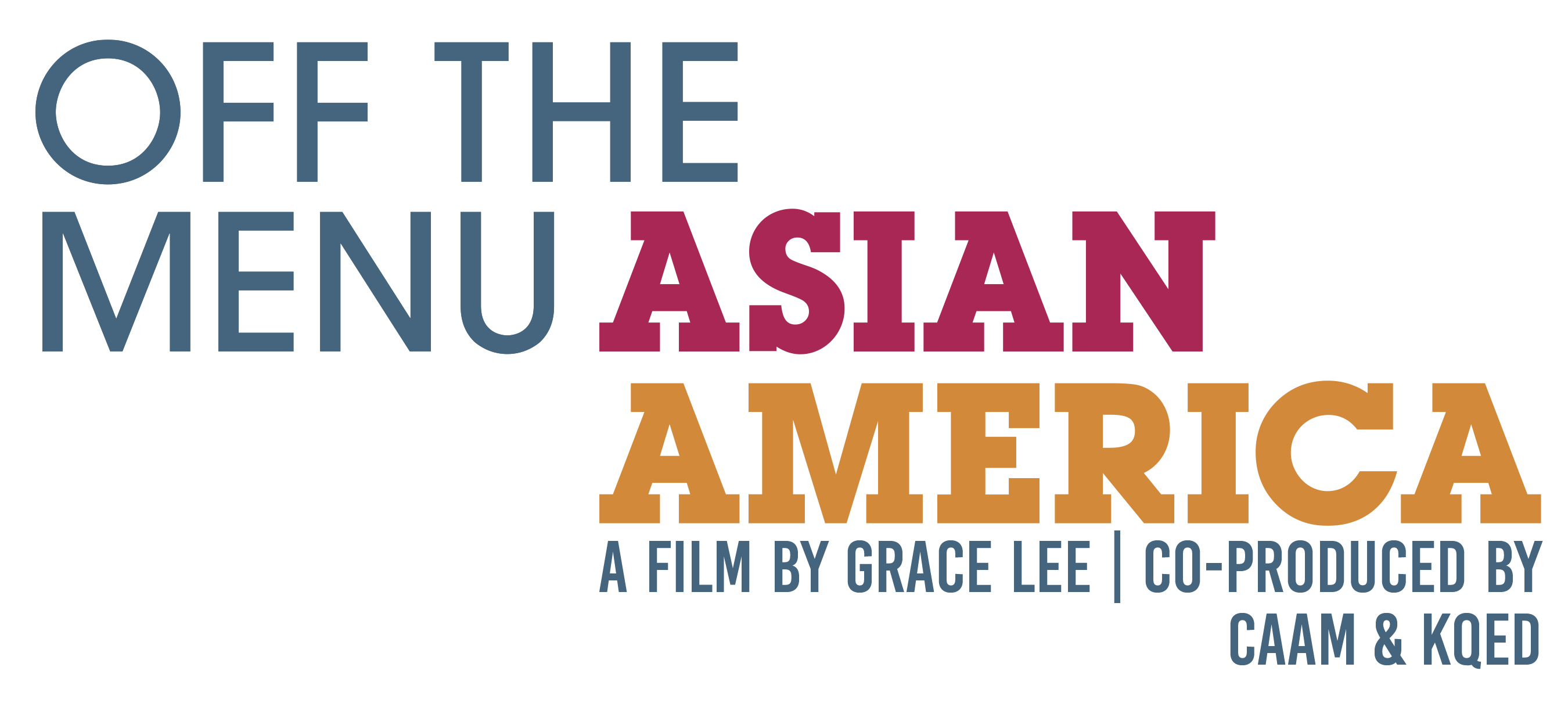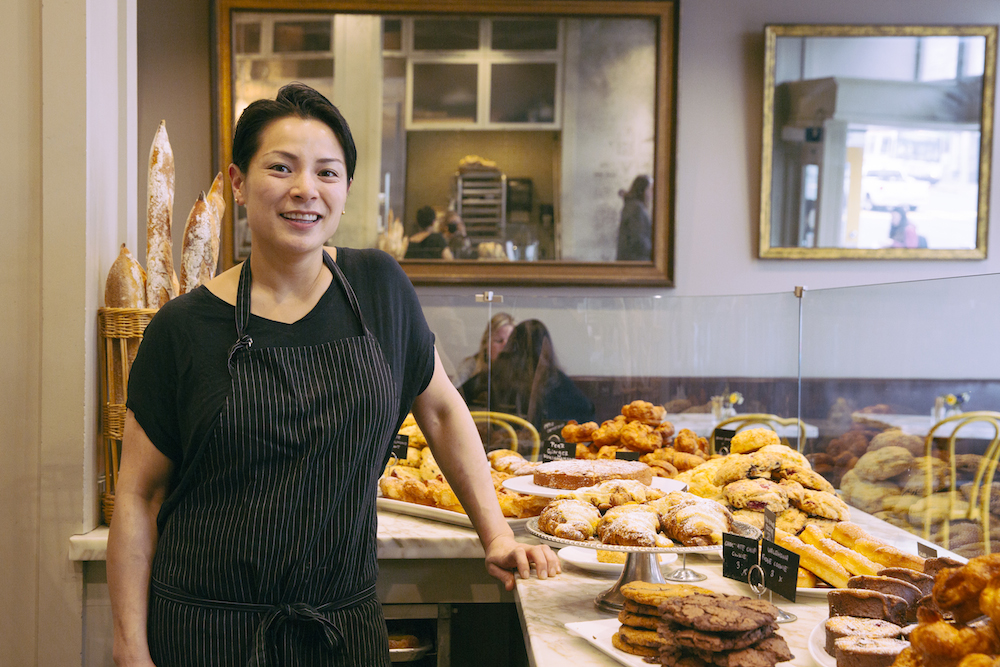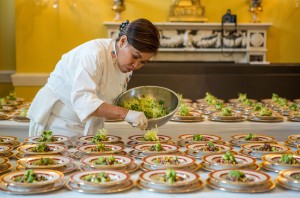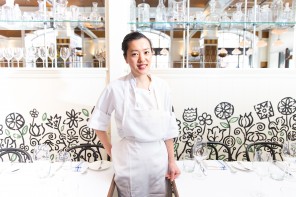Belinda Leong’s long held vision of bringing a French-inspired bakery to San Francisco has come to fruition after years of serious, hard work. After getting her culinary start at Restaurant Gary Danko, Leong staged at two of the most prestigious culinary institutions in the world: Noma in Copenhagen and Pierre Hermé in Paris. After partnering with another heavy hitter in French pastries, Michel Suas, b.patisserie officially opened in 2013. With just one year in, Leong was a James Beard Award finalist for Best Pastry Chef and secured June 20th to be the national food holiday for Kouign Amanns, the flakey butter cakes from Breton. Mark your calendars.
—Diana Emiko Tsuchida
Was there anything from childhood that set the stage for creating a life around food?
My family manufactured Chinese ingredients, like sausage and wontons. They had been in the manufacturing business for a long time and I’d been in the factories. My parents always ate well and we were exposed to good food and our palates were probably trained. Training our palates for different foods–what’s mediocre, what’s good. We always traveled a lot so we were exposed to a lot of different foods and cuisines.
What was it about French pastries that appealed to you specifically?
When anyone thinks about pastries, you think French. I’ve always liked the technique and I knew that if I wanted to do it, France is where you go. I’ve always loved the style of the French but I enjoy a Chinese pastry. I guess that’s comfort because that’s what I was exposed to growing up. My pastries are not that sweet so we definitely cater to a lot of Asians. I always cut back on the sugar. I like my pastries lighter and less sweet.
Have you felt any discrimination in the kitchen due to race or gender?
In all the kitchens I worked at, I never felt any discrimination. I believe that women can prove themselves because they can do everything men can do. I was doing what they were doing. If women do the same work as men, and the results are good, they get the same respect. And I’ve worked in some pretty tough kitchens in France but I didn’t really come across it.
How do you lead your staff?
The words we live by is to have fun with what we’re doing. Even when I started my business partnership I just wanted to make sure we had fun in opening the shop, because I’m very passionate about what I do so if I’m not having fun then everything changes–you can see it in the pastries, you can see it in the energy of the shop so what we created was an elegant pastry shop but in a casual, open atmosphere. We wear t-shirts and not chef jackets so it’s more casual and people can see what we’re doing. We get all walks of life coming through the shop, so it’s good that everyone’s comfortable. It’s not the type of pastry shop you’d actually see in France. The ones in France are quiet are everyone’s quite serious. In the pastry shop I worked at in Paris, everyone’s in their black suits, gloves and they’re all staring at you. It’s like you’re in a jewelry shop. But that’s France and it’s a different culture. Being in the industry in San Francisco, I knew what people would want. And myself, I do like nice things but I’m quite casual.
What’s your advice to other young chefs who identify as a minority?
I think you need to set a goal and just keep looking at that goal. And you do everything you need to do to get there and all the other bumps and obstacles you go through shouldn’t affect your vision. You’ve got to keep focused and you’ve got to keep striving to pursue that goal. I knew I wanted a pastry shop and I knew I wanted to work at the best places in the world. I didn’t know how I was gonna get there but I knew I wanted to work at Pierre Herme, I wanted to be at NOMA, I knew I wanted to work at Gary Danko, and so I did whatever it took to get to those places. So you have to work hard and find a connection. I knew I wanted my shop to be French pastries so I knew I had to learn it. France was so hard, I never spoke a word of French and never took a French lesson. I just went there blindly and I didn’t have an apartment or anything. It was the scariest thing and I never moved away from home. I just knew I wanted to be at Pierre Herme and I didn’t understand anything the first month or so. But time goes by and it just gets better–it always gets better. Of course it was the biggest obstacle but that was my goal. I set one goal at a time. You’ll appreciate everything after because you’ve gone through it. All those obstacles along the way that you meet can’t change your goal. You can’t say “It’s too hard, I can’t do it.” Or else I would’ve quit a long time ago. Just keep looking at it.
What do you want to be remembered for?
I’d say bringing San Francisco an established place where people can have great pastries with a great atmosphere with happiness. That I brought my hometown an establishment like this, that people came for our pastries and they love being here. This is where I grew up, this is where I was born. To bring something like that here is a wonderful feeling.
+ + +
 This story is a part of Off the Menu: Asian America, a multimedia project between the Center for Asian American Media and KQED, featuring a one-hour PBS primetime special by award-winning filmmaker Grace Lee (American Revolutionary: The Evolution of Grace Lee Boggs), original stories and web content.
This story is a part of Off the Menu: Asian America, a multimedia project between the Center for Asian American Media and KQED, featuring a one-hour PBS primetime special by award-winning filmmaker Grace Lee (American Revolutionary: The Evolution of Grace Lee Boggs), original stories and web content.



